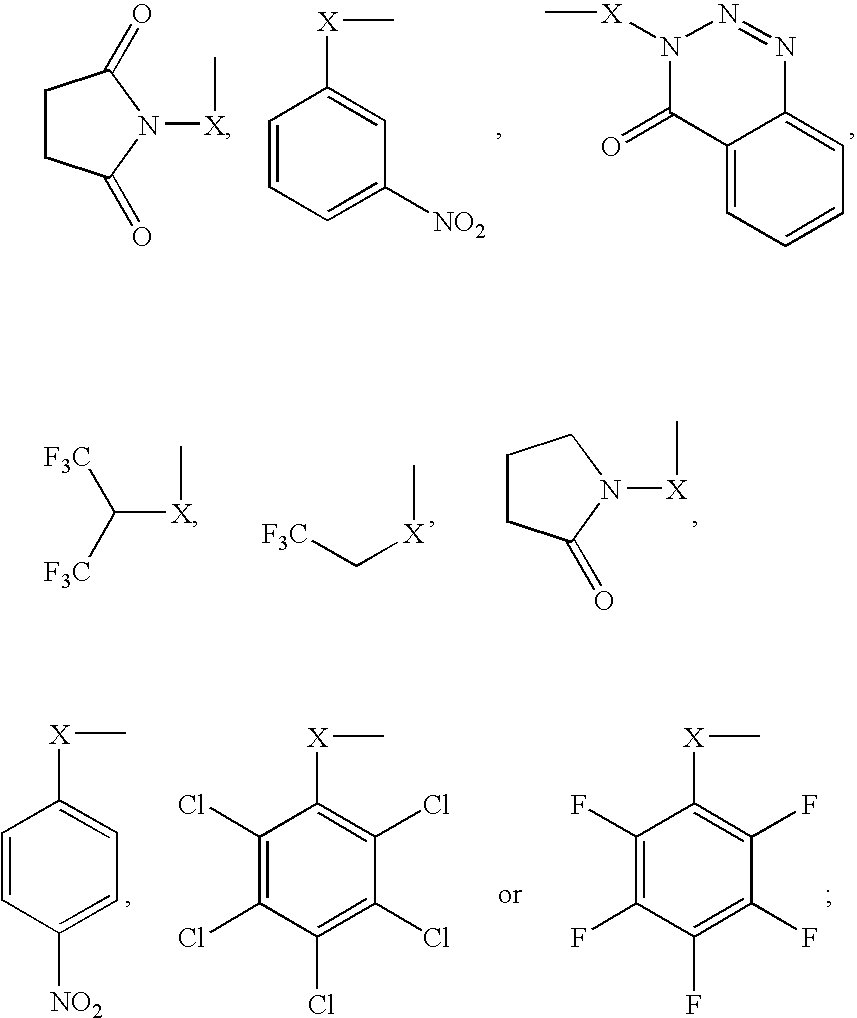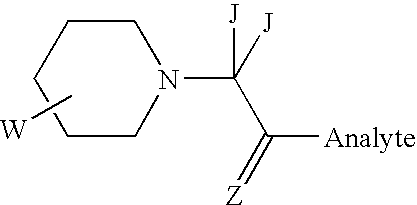Methods and mixtures pertaining to analyte determination using electrophilic labeling reagents
an electrophilic labeling and analyte technology, applied in the field of methods and mixtures pertaining to analyte determination using electrophilic labeling reagents, can solve the problems of difficult or impossible detection of reporter fragments above background noise, difficult or time-consuming, and difficulty in interpreting cid spectra to assemble the amino acid sequence of the parent peptide de novo,
- Summary
- Abstract
- Description
- Claims
- Application Information
AI Technical Summary
Problems solved by technology
Method used
Image
Examples
example 1
Synthesis Of Morpholine Acetic Acid
[0205] Bromoacetic acid (2 g, 14.4 mole) was dissolved in tetrahydrofuran (50 mL) and added dropwise to a stirred solution of morpholine (3.76 g, 43.2 mole) in tetrahydrofuran (THF, 20 mL). The solution was stirred at room temperature for three days. The white solid (4.17 g) was filtered, washed with THF (100 mL), and recrystallised from hot ethanol (EtOH), Yield: 2.59 g: IR:1740 cm-1. For the two different isobaric versions of morpholine acetic acid, either bromoacetic-1-.sup.13C acid (Aldrich PN 27,933-1) or bromoacetic-2-.sup.13C acid (Aldrich PN 27,935-8) was substituted for bromoacetic acid.
example 2
Synthesis Of Morpholine Acetic Acid N-Hydroxysucciniimide Ester
[0206] Dimethylformamide (dry, 1.75 g, 0.024M) was dissolved in tetrahydrofuran (dry, 30 mLs). This solution was added dropwise to a stirred solution of thionyl chloride (2.85 g, 0.024M) dissolved in tetrahydrofuran (dry, 20 mLs) and cooled in an ice bath. After complete addition and 30 minutes on ice, the ice bath was removed and solid N-hydroxysuccinimide (2 g, 0.017 M) was added (which completely dissolved) immediately followed by solid pre-powdered morpholine acetic acid [or -1-.sup.13C or -2-.sup.13C morpholine acetic acid] (3.64 g, 0.016M). The morpholine acetic acid dissolved slowly giving a homogeneous solution that rapidly became cloudy. The reaction was left vigorously stirring over night at room temperature. The white solid was washed with tetrahydrofuran and dried under vacuum, weight 3.65 g (67%), IR spectrum 1828.0 cm-1,1790.0 cm-1,1736.0 cm-1.
example 3
Analyte Determination and Relative Quantitation in Two Samples
[0207] 100 pmole amounts of freeze-dried Glu-Fibrinopeptide B (Sigma) were reacted with 200 .mu.l of freshly-made 2% w / v solutions of either I or II (See: FIG. 1A for structure and Examples 1 & 2 for preparation) in ice-cold 0.5M MOPS buffer (pH 7.8 with NaOH) for 30 minutes on ice. The reaction was terminated by the addition of TFA to 0.5% v / v final concentration. The modified peptides were then mixed in various pre-determined proportions to approximately cover the range 1:10 to 10:1 of the differentially labeled peptides. Each peptide mixture was individually purified by reverse-phase de-salfing using a Millipore C18 Zip-Tip. Excess reagent and buffer do not retain on the reverse-phase packings, and were thus efficiently removed prior to MS analysis. The mixtures (0.5 .mu.l) were then spotted onto a MALDI target plate, over-spotted with 0.5 .mu.l of 1% w / v .alpha.-cyano cinnamic acid in 50% aqueous acetonitrile and each...
PUM
| Property | Measurement | Unit |
|---|---|---|
| gross mass | aaaaa | aaaaa |
| mass | aaaaa | aaaaa |
| molecular weight | aaaaa | aaaaa |
Abstract
Description
Claims
Application Information
 Login to View More
Login to View More - R&D
- Intellectual Property
- Life Sciences
- Materials
- Tech Scout
- Unparalleled Data Quality
- Higher Quality Content
- 60% Fewer Hallucinations
Browse by: Latest US Patents, China's latest patents, Technical Efficacy Thesaurus, Application Domain, Technology Topic, Popular Technical Reports.
© 2025 PatSnap. All rights reserved.Legal|Privacy policy|Modern Slavery Act Transparency Statement|Sitemap|About US| Contact US: help@patsnap.com



